Getting Started in IMAC Competition
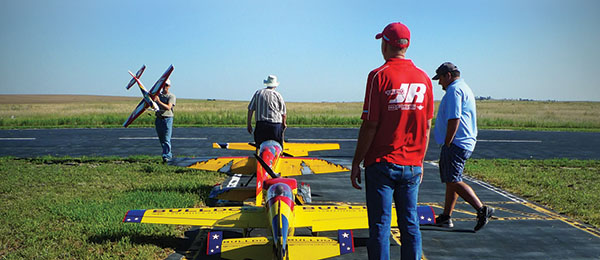
Written by Mike Hurley Improve your flying skills while making new friends Column As seen in the July 2015 issue of Model Aviation.
Getting Started in IMAC Competition
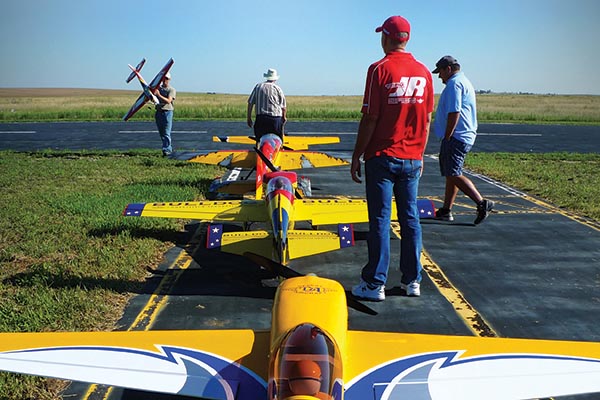
You’ll see big airplanes at IMAC contests, but don’t be intimidated. You can fly any size scale aerobatic model in IMAC.
I fly in International Miniature Aerobatic Club (IMAC) competition for a lot of reasons. I love scale aerobatic aircraft and I love the way they fly. I like the fluid symmetry of the sequences that we fly and the satisfaction of finally being able to do a figure that has been so tough for me to learn. Most of all, I enjoy the camaraderie of like-minded fellow pilots in IMAC. I fly IMAC because the people are my kind of people and we have a fantastic time. We learn, we laugh and joke, and we help each other out in every way from tips about flying, to helping set up or fix an airplane, sometimes even lending a fellow competitor a model to fly when he or she needs it. Competing has only a little to do with why I fly IMAC. For me the best part is friends, and the goals that I set for myself help keep me motivated. I know the excuses and I understand that life is full and we have only a small window to enjoy our RC hobby, but I say use that small amount of time focused on a goal and your time will be so much richer for it. Check out this season’s IMAC contest schedule in your area, clear off a few of those weekends well in advance, and get ready for IMAC 2015. By this time next year, you’ll be a better pilot, have a reason to fly, and have new friends with a common interest. I hope that I’ve interested you in giving IMAC a try this year, so here’s a short introduction and some steps to help you understand and to prepare for your first IMAC competition. First, let’s talk about the airplane. One generally sees IMAC pilots competing using giant 35% and 40% aircraft. These large aircraft are easier to fly and easier to control, but I promise that they are not necessary to achieve what we’ve discussed so far. A big airplane will not make you a better pilot, it won’t help you have more fun, and it probably won’t win you any new friends. You can go quite far in IMAC with an airplane that you might already own. In fact, the basic sequences can be flown with any aircraft you choose. It would probably help you to fly an aircraft that is fairly symmetrical, can fly straight, and has an axial roll. I’ve seen pilots fly in IMAC with a Cub, but that would be much harder than with something like my old Chaos. Of course, scale aerobatic Edges, Extras, and Yaks are so popular for 3-D that chances are you probably already have a terrific airplane to start with. Even a small model is fine; there’s no size requirement in any IMAC class.
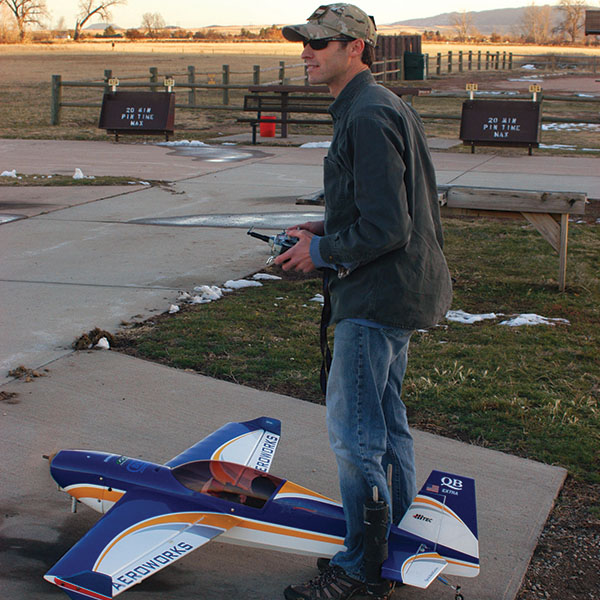
This 20cc Extra 300 is typical of an entry-level scale aerobatic airplane that would be competitive at Basic and Sportsman levels.
IMAC competitions are broken into five classes: Basic, Sportsman, Intermediate, Advanced, and Unlimited. Basic is where most pilots start and it has the simplest sequences. In the Basic class you can fly any aircraft of any size. Sequences are composed of 10 maneuvers and the difficulty of the maneuvers increases with each class level. The sequences for each class change annually. To understand what your maneuvers are and how to fly them, IMAC uses the full-scale Fédération Aéronautique Internationale (FAI) standards document called the Aresti system. Aresti is intuitive. With only a first look, you can figure out what’s going on without ever having seen an Aresti diagram. But there are some nuances that can trick you when you start to read the diagrams for the more advanced classes. We won’t worry about those fine details because by the time you get through your first couple of practice sessions and a contest or two, you’ll start to understand how to read the diagrams. To get the sequence for your class, visit the IMAC website and download the PDF file for your class. (See the “Sources” listing.) In the upper classes, it sometimes helps to write out the sequence the way you like to hear it called to you. This helps you memorize your sequence. When you fly in a contest, you will have someone standing behind you telling you what maneuvers to fly. We call this person a caller. The caller helps keep you on track in the routine, spots for you (because in most contests you’ll be flying with another contestant in the air at the same time), and communicates with the judges while you concentrate on flying your airplane.
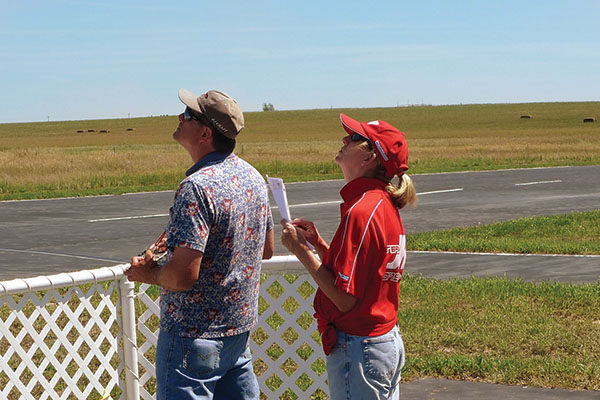
In addition to spotting, a caller needs to watch the flight to call each maneuver at the right moment.
In the Basic class, maneuvers are mostly made up of maneuvers you probably already do—a roll, a loop, maybe a Half Cuban 8, or a stall turn—nothing that would shake up a reasonably seasoned sport flier. The tough part comes in putting them altogether, flying straight and true between them, and placing them where they need to be in the airspace. You’ll be surprised at how difficult it is to fly a truly round loop with a straight horizontal line before and after. And that’s where practice comes into play. Now that you’ve decided to give IMAC a try, instead of just performing your usual snaps, loops, and rolls, you have a goal to shoot for with each flight. Think of it as sport flying with a purpose—not in addition to your normal weekend flying, but instead of your normal weekend flying. And, before you know it, you’ll be learning, achieving, and pretty darn proud of your advancements. What does contest day look like? What can you expect? The first contest is intimidating. Your first flight will be something of a blur. You’ll be anxious, which is why you’ll need a good caller to keep you calm, on track, and help you understand what’s going on around you while you’re flying. On contest day, you arrive fairly early in the morning. Everybody will be busy setting up airplanes and registering for the contest. There will normally be two flightlines. This means that two pilots fly at the same time with one pilot station to the left and the other to the right side of the runway. Pilots fly in front of two judges, each often with a helper called a scribe. The scribe can call the maneuvers for the judges if desired and the scribe writes in the pilot scores as directed by the judge. After all of the pilots have registered, there will be a pilots’ meeting. Sometimes these have a thorough explanation of how the day will proceed. Sometimes they are brief without much information. Each class will be assigned a flightline for each round and the pilots will be given a flight order. A round is one flight of two full sequences. A sequence is your set of 10 maneuvers or figures. The contest is a two-day event. You’ll fly three rounds on the first day and two rounds on the second day. Additionally, there will be an Unknown round for everybody except those in the Basic class. Basic will fly an additional Known round instead of an Unknown. (I’ll discuss Unknown sequences later.) The last part of the second day is often a separate Freestyle competition. Any pilot registered in the IMAC contest can fly in the Freestyle. It is a separate judged flight and not mandatory. Throughout the contest the flightline can get pretty hectic with two stations running and pilots ready to take off from both stations. A line boss will direct the flow of traffic for takeoffs and landings. The flight order will be posted at each flightline. All you have to do is find out when you fly (e.g., I’ll fly third or I’ll fly after Bill) and line up your airplane on the flightline in the right order. Your caller should bring the score sheets that you received at registration to the flightline. He or she will hold your airplane as you start it. Watch the pilot flying before you as he or she flies the second sequence. The contest will likely run in a manner that has you take off and get ready for your pair of sequences before the pilot ahead of you lands. This can be tricky, but when you get used to it, it’s actually fun. You start your engine and take off when the line boss gives you clearance, usually at the seventh maneuver of the flight before you. When the pilot ahead of you finishes his or her flight, the four of you (you and your caller and the last pilot and his caller) switch places. Your caller gives the score sheets to the scribes for each judge and declares a direction of flight (right to left or left to right) so that the judge can use the proper Aresti diagram to follow your flight. As you get ready to start your sequence you’ll want to get your airplane straight and level, flying a perfect horizontal line toward the area where you’ll start your first maneuver. When the airplane is on the track you want and you’re ready to start your sequence, you call out “in the box,” signifying the start of your sequence. From that point on, every line you fly will be judged, including the horizontal lines between maneuvers. Your caller will call each maneuver as you fly it. Stay calm and don’t rush—you have all the time you need and flying bigger figures in a more relaxed manner will make you look like a pro and give you more time to correct as you fly, keeping you set up for the next figure. Now you’re in your first flight and this is where things become tense. You’ve memorized the sequence that you’ve flown dozens of times, but you just cut off the last part of that loop and you can’t stop thinking about that mistake! I mean, you’ve done it perfectly in practice; what the heck just happened? “Oh yeah, I have to do another figure now, uh, what was it? I can’t remember!” And then out of the haze you hear your caller behind you calling “two-point roll” and you snap out of it. Yes, this really does happen, even to seasoned pilots. When you’ve finished the 10th figure of the first sequence in your flight and you have your airplane straight and level, you call “out of the box” to the judges. This signifies the end of judging your first sequence. Here you have a few seconds to catch your breath, relax, and line up for a perfect start to the first maneuver of the second sequence. You are allowed to make a pass before you start the second sequence if you need to get your thoughts in order. The second sequence is the same as the first, except this time you nail that loop and you can’t stop thinking about it—causing you to mess up the next three maneuvers. After you’ve called “out of the box” at the end of the second sequence, you switch places with the pilot who flies after you, then you land and shut down your engine. Your caller retrieves your airplane from the runway. The pressure is off and this huge grin starts to form on your face. What a rush! Now it’s time to go back to your pit area and refuel the airplane or recharge the batteries, and think about your last flight. Soon your fellow competitors will wander over, commenting “Good flight, man!” or “What happened on the loop in the first sequence?” And you give it right back to them. You feel great because the flight is over, you did much better than you thought you would, and you think, “Wow that was fun.” You watch the next few flights but this time with a knowing grin. Often during a contest you’ll be asked to scribe, and after you get a few contests under your belt, you’ll be asked to read the judge’s manual and sit in the judge’s chair. It’s an honor to judge your fellow pilots and you have an obligation to be fair and unbiased. Every judge does his or her best. At the end of the first day, all of the upper classes will be given a sequence of Unknown figures. An Unknown is a sequence that you’ve never seen before and have never practiced. You aren’t allowed to fly after the Unknowns are handed out. Most pilots study the Unknown sequence the entire night and all morning on the second day of the contest. This is when you see all of the pilots “dry-flying” with a stick model. The stick model helps pilots visualize the sequence. Because you can’t practice, this is the best way to try and understand what you’re about to fly. Pilots will fly only one sequence of their Unknown as the first round (as opposed to two sequences per flight of the Knowns). The Basic class pilots will instead fly an additional round of their Known sequence. After all of the Precision rounds have been flown, the contest ends and the Freestyle competition begins. This is different from full-scale International Aerobatic Club (IAC) competitions where the Freestyle competition is mandatory and a significant part of a pilot’s score. In IAC, Freestyle is often another set of figures created by each individual pilot. They generally don’t fly 3-D. In IMAC, Freestyle is often a huckfest of sorts. I’m not the best 3-D pilot but I always fly in the Freestyle and I encourage others to do so as well. It’s a lot of fun and gives you a chance to let it all out after two days of nothing but Precision flying. You are allowed to fly an airplane other than the one you flew in the Precision portion of the contest and you can fly to music. The really good Freestyle fliers choreograph their routine to the music, but I normally just fly while some cool music is playing and hope by some coincidence it looks like it works together.
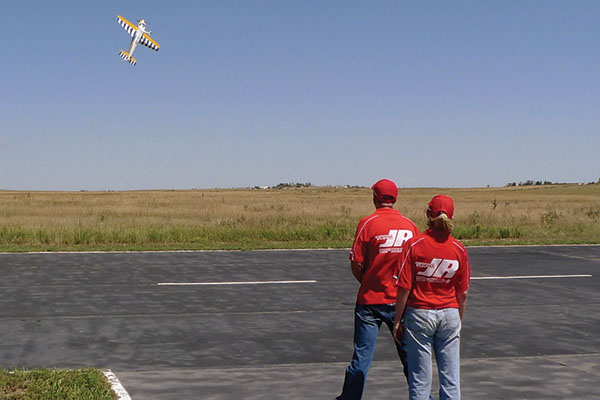
The 4-minute Freestyle flight gives pilots a chance to showcase their choice of Precision or 3-D maneuvers. It is usually choreographed to music.
At the end of the day, trophies and prizes are handed out and it’s time to congratulate the winners. This part can get to some people and is why competition can lead to hard feelings. I tend to get worked up and sometimes I have to remind myself why I’m here. I’m here for good times, to improve my flying, and for good friends and fellowship, and no matter how I did in the contest, I’ve achieved those goals. It’s hard for pilots who haven’t experienced a contest to understand, but you just don’t get the same kind of fun and kinship by going to the field on the weekends and sport flying. Now that you know what to expect and what you’ll gain from flying in IMAC, I know you’ll want to give it a try. If you live in the Denver area you can contact me and I’ll be happy to give you any tips or help if I can. Nearly all of the information that you’ll need to get started in IMAC competition can be found on the organization’s website. Download the sequence that you want to try and give it a go. Look at the contest schedules for your region of the country and mark the contest dates on your calendar. If you’d like to just get a feel for the contests, come out to watch or maybe sit in as a scribe for one of the judges. I think that by the next contest date you’ll be ready to fly.
Remembering Norm Cassella
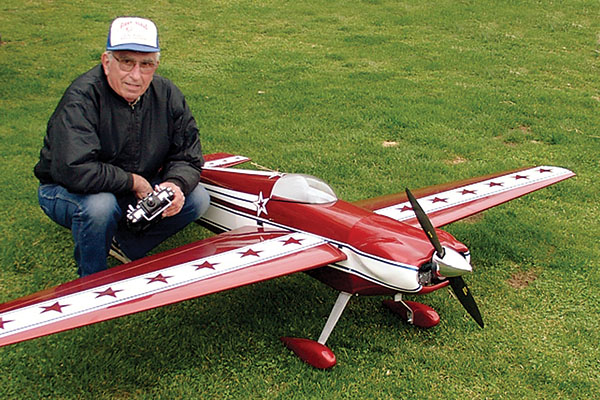
The author was inspired by Norm Cassella, founding IMAC member and former IMAC president, shown here with his 1/3-scale Laser 200.
Each time I compete, I’m taken back to those days in the Poconos practicing, flying, and joking with my buddy, Norm Cassella. Norm passed away this past year at age 86 and I will forever remember him fondly, and remember some of the best times of my life flying and building RC aircraft. Norm was a founding member of IMAC and served as its president and vice president for several years. In addition to his fantastic flying accomplishments, Norm was a prolific designer and builder. He designed the Pulsar Biplane, one of the first Precision Aerobatics biplane designs, and he scratch-built 33%-scale Lasers for dozens of fliers on the East Coast. Norm flew in the Unlimited class in IMAC, winning often enough to be one of the few pilots invited to fly in the early Tournament of Champions contests held in Las Vegas. He also performed air shows with his Laser and was asked to give demos at RC events along the East Coast. Norm was a man with honesty and integrity as key values. He treated the hobby of RC, and especially IMAC Precision Aerobatics, with reverence. He was a sophisticated man with old-world moral character. His friendship meant a great deal to me and many others. He will be missed. I want to dedicate this article to him. Our chance meeting back in 1997 influenced the rest of my life. —Mike Hurley [email protected]










1 comments
Norm Cassella
Add new comment